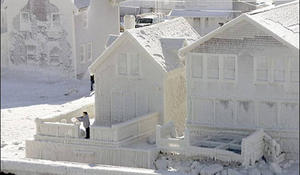Climate conundrumDramatic climate change is unpredictable
Scientists examine two models to explain climate change; one scenario is like a seesaw that has tipped to one side; if sufficient weight is placed on the other side the seesaw will tip — the climate will change from one state to another (an ice age, or warmer climate as is the case today); in the other model, the climate is like a ball in a trench, which represents one climate state; the ball is continuously pushed by chaos-dynamical fluctuations, and the turmoil in the climate system may finally push the ball over into the other trench, which represents a different climate state

Abrupt climate change has happened before // Source: wunderground.com
The fear that global temperature can change very quickly and cause dramatic climate changes that may have a disastrous impact on many countries and populations is great around the world. What causes climate change, however, and is it possible to predict future climate change?
New research from the Niels Bohr Institute at the University of Copenhagen shows that it may be due to an accumulation of different chaotic influences and as a result would be difficult to predict. The results have just been published in Geophysical Research Letters.
For millions of years the Earth’s climate has alternated between about 100,000 years of ice age and approximately 10-15,000 years of a warm climate like we have today. The climate change is controlled by the Earth’s orbit in space, that is to say, the Earth’s tilt and distance from the sun. There are also other climatic shifts in the Earth’s history, however, and the question is: what caused those shifts?
Dramatic climate change of the past
By analyzing the ice cores that are drilled through the more than three kilometer thick ice sheet in Greenland, scientists can obtain information about the temperature and climate going back around 140,000 years.
The most pronounced climate shifts besides the end of the ice age is a series of climate changes during the ice age in which the temperature suddenly rose 10-15 degrees in less than ten years. The climate change lasted perhaps 1,000 years, then — bang — the temperature fell drastically and the climate changed again. This happened several times during the ice age and these climate shifts are called the Dansgaard-Oeschger events after the researchers who discovered and described them. Such a sudden, dramatic shift in climate from one state to another is called a tipping point. The cause of the rapid climate change, however, is not known and researchers have been unable to reproduce them in modern climate models.
The climate in the balance
“We have made a theoretical modeling of two different scenarios that might trigger climate change. We wanted to investigate if it could be determined whether there was an external factor which caused the climate change or whether the shift was due to an accumulation of small, chaotic fluctuations,” explains Peter Ditlevsen, a climate researcher at the Niels Bohr Institute.
He explains that in one scenario the climate is like a seesaw that has tipped to one side. If sufficient weight is placed on the other side the seesaw will tip — the climate will change from one state to another. This could be, for example, an increase in the atmospheric content of CO2 triggering a shift in the climate.
In the second scenario the climate is like a ball in a trench, which represents one climate state. The ball will be continuously pushed by chaos-dynamical fluctuations such as storms, heat waves, heavy rainfall, and the melting of ice sheets, which affect ocean currents and so on. The turmoil in the climate system may finally push the ball over into the other trench, which represents a different climate state.
Ditlevsen’s research shows that you can actually distinguish between the two scenarios and it was the chaos-dynamical fluctuations that were the triggering cause of the dramatic climate changes during the ice age. This means that they are very difficult to predict.
Warm future climate
What about today — what can happen to the climate of the future? “Today we have a different situation than during the ice age. The Earth has not had such a high CO2 content in the atmosphere since more than 15 million years ago, when the climate was very warm and alligators lived in England,” Ditlevsen says. “So we have already started tilting the seesaw and at the same time the ball is perhaps getting kicked more and could jump over into the other trench. This could mean that the climate might not just slowly gets warmer over the next 1,000 years, but that major climate changes theoretically could happen within a few decades,” estimates Ditlevsen, but stresses that his research only deals with investigating the climate of the past and not predictions of the future climate.
—Read more in P. D. Ditlevsen and S. J. Johnsen, “Tipping points: Early warning and wishful thinking,” Geophysical Research Letters (24 August 2010) (doi:10.1029/2010GL044486) (sub. req.)
